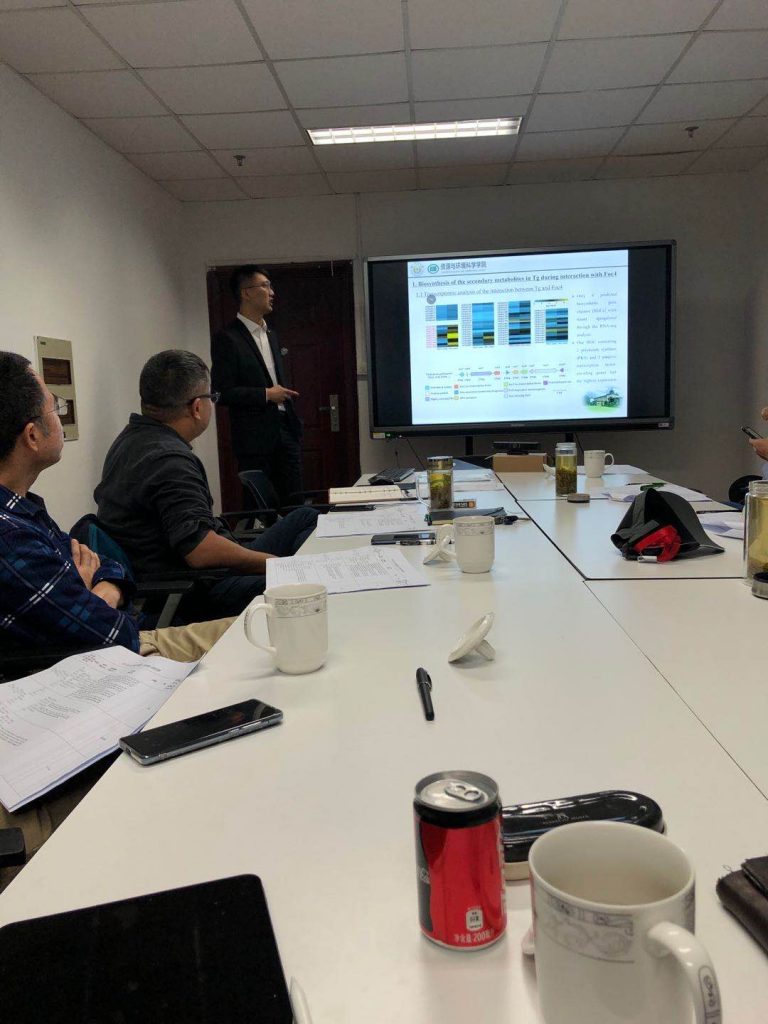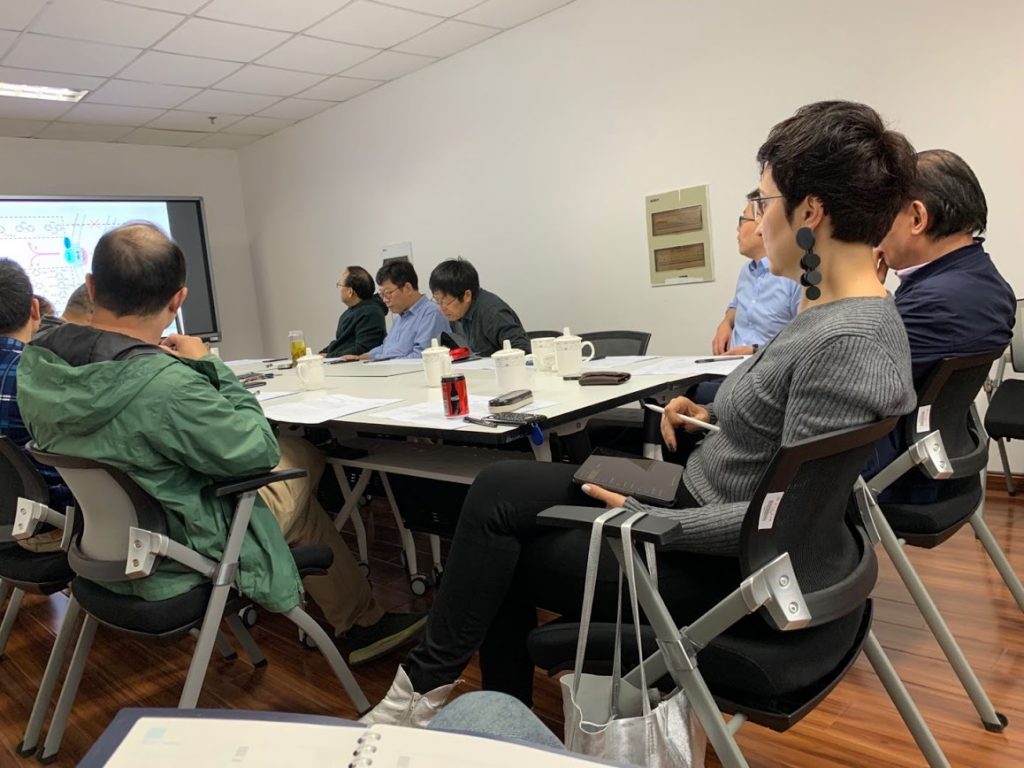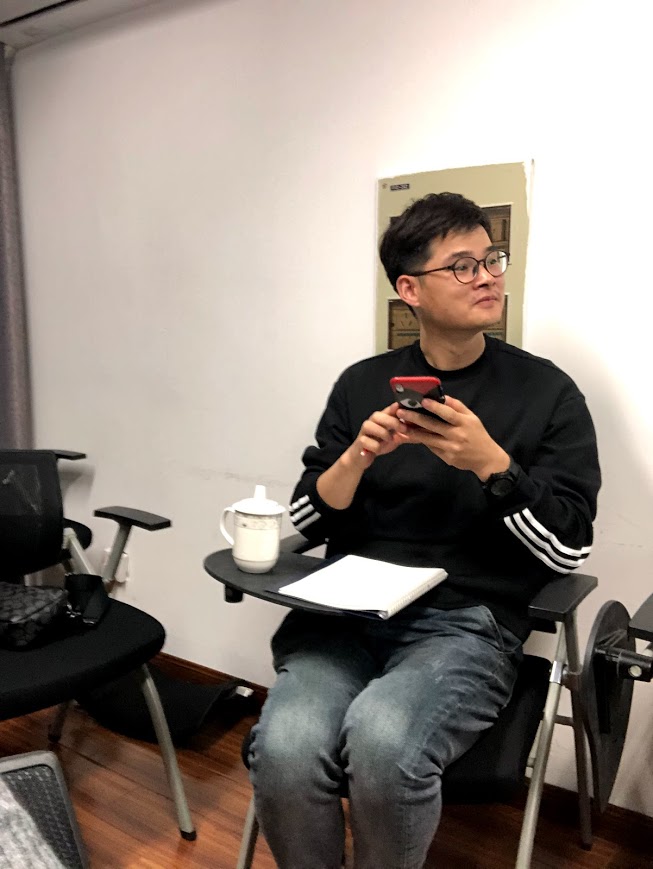
Guan Pang presenting on the College hearings for the university-funded Postdoc position


Virtual fungal genomics laboratory of Irina S. Druzhinina and Feng Cai



Siqiao Chen, a FungiG Ph.D. guest student researching the fungal-like bioeffectors used to control plant disease caused by Pythium spp. pathogen.
We studied the diversity of Trichoderma (Hypocreales, Ascomycota) – Pythium (Peronosporales, Oomycota) antagonistic interactions on a taxonomically-wide scale for a better understanding of the molecular mechanisms governing microbial dialogues in environmentally friendly control to Pythium diseases by next next-generation bioeffectors. For this purpose, we set a library of Trichoderma strains that represent the major taxonomic clades, and investigated their interactions with five species of causative plant diseases Pythium, and revealed that the ability to suppress Pythium is a generic property of Trichoderma as most species showed profound antagonism regardless of the partner identity. Furthermore, the soil-dwelling species, such as T. asperellum, T. atroviride and T. virens showed to be the most efficient. In contrast, canopy-associated and putatively strictly mycoparasitic species (T. minutisporum, T. parepimyces, and T. strictipile) were only moderately antagonistic to Pythium spp. These results suggest that the interactions with Pythium spp. benefit from the shared (core-genome) genetic traits of Trichoderma, such as hydrolytic enzymes that can degrade cellulose, one of the main polysaccharides of the water mold cell wall. Therefore, we harnessed exo-proteomics in combative interactions by liquid culture with Pythium mycelia to analyze the contribution of exo-emzymes (e.g. cellulases and proteases) to the antagonism. We also exploited the mutant of the highly cellulolytic species T. reesei lacking XYR1, which is the major transcriptional activator of cellulase gene expression to investigate the contribution of cellulases to the antagonism. The T. reesei △xyr1 mutant showed reduced antagonism levels to all of the five Pythium plant pathogens species analyzed compared to the wild-type. Still, the ability of Trichoderma to inhibit Pythium spp. was not abolished, suggesting other factors contributed to the antagonism. Our goal is to figure out the potential of Trichoderma bioeffectors to control diseases caused by Pythium plant pathogens, and molecular mechanisms of the multi-faceted nature of the antagonism.
Siqiao Chan,B.Sc.(Ag.)
Professional address: Nanjing Agricultural University, Weigang 1th, Nanjing, 210095, Nanjing, Jiangsu, China
E-mail: 33315220@njau.edu.cn
Born on: Aug/15/1996, Huizhou, Guangdong, China
Web links: www.FungiG.org & ResearchGate
Sept/2019 ꟷPresent Directly Ph.D. study, College of Resources and Environmental Sciences, Nanjing Agricultural University, and Plant Protection Institute, Jiangsu Academy of Agricultural Sciences, Nanjing, China. Supervisor: Prof. Dr. Qirong Shen Advisory board: Prof. Dr. Irina S. Druzhinina, Dr. Paul Daly.
Dec/2018 ꟷMar/2019 Undergraduate graduation thesis. Supervisor: Prof. Dr. Irina S. Druzhinina and Dr. Feng Cai
Jul/2018 ꟷAug/2018 Academic Summer camp, Boston, USA
Sept/2015 ꟷJul/2019 B.S. in Agro-grassland science, College of Resources and Environmental Sciences, Nanjing Agricultural University, Nanjing, China
Keywords: Fungal-like bioeffectors to Pythium plant diseases, fungal cellulases, exo-proteomics, fungal wars, Trichoderma genetic engineering.
Microbiological techniques: Axenic cultures, microbial diagnostics by DNA barcoding, fungal morphology, microbial cultivations, light, confocal, and scanning electron microscopy techniques.
Molecular biological techniques: Qualitative and quantitative nucleic acid manipulation techniques, protoplast transformation of Trichoderma and Pythium.
Proteomic and analytical techniques: Fungal exo-proteomics and basic proteomic assays, metaproteomic analysis
Fungal ecophysiology: BIOLOG phenotype microarrays, qualitative assays for enzymatic activity, dual confrontations of fungi, growth profiling.
Microbial metagenomics: Transcriptomics sequencing for fungi and Oomycota, absolute quantification technique, qPCR
Molecular evolution: Phylogenetics analyses, DNA barcoding of fungi and Oomycota
Other skills: Plant physiology, plant biochemical assays and nutrition
External lab member, maternity leave

Secretary
Office hours:
Monday to Friday 8:30 – 12:00 and 14:00 – 17:30
Phone: +86 (0)25 84396890
Fax: +86 (0)25 84396890
Email: 691279904@qq.com
About me:
I obtained my master’s degree from Nanjing Agricultural University in 2011. My master thesis research was focused on analyzing and identifying the mycorrhizal fungi associated with pine trees. After that, I had a two-years training in the molecular ecology of ectomycorrhizal fungi at the University of Tokyo. During that time, I also served as an instructor for international students in Japan and taught the Chinese language. In Nanjing, I worked as a high school English teacher. After the maternity leave, I joined FungiG in July 2019.
new group member
Pang G., Sun, T., Yu, Z., Yuan, T., Liu, W., Zhu, H., Gao, Q., Yang, D., Kubicek, C.P., Zhang, J., Shen, Q. (2020) Azaphilones biosynthesis complements the defence mechanism of Trichoderma guizhouense against oxidative stress, https://doi.org/10.1111/1462-2920.15246
A visiting researcher working on the taxonomy and identification of Trichoderma
Hi there, I am Peijie Chen, and I have started my PhD project in September 2020 in Fungal Genomics Group. I have been curious about winemaking since I was a child, and the mechanism behind this is even more fascinating. From genes to proteins (enzymes), simple ATCG permutations and combinations create unlimited possibilities. This also gives us the possibility of manipulating genes to obtain ideal microorganisms. I am now working on genetic engineering of Aureobasidium spp. and Trichoderma spp. for better CAZyme production so that we can achieve high utilization of massive plant biomass and better renewable resources production.
Here are my recent publications:
Jiang, G., Chen, P., Bao, Y., Wang, X., Yang, T., Mei, X., Banerjee, S., Wei, Z., Xu, Y., Shen, Q. 2021. Isolation of a novel psychrotrophic fungus for efficient low-temperature composting. Bioresource Technology. 331: 0960-8524.
Chen, P, Pang, G, Cai, F, Druzhinina, I. S. 2021. Strain Improvement and Genetic Engineering of Trichoderma for Industrial Applications. Zaragoza O., and Casadevall A., eds. Encyclopedia of Mycology, Elsevier pp 505-517.
Cai, F., Zhao, Z., Gao, R., Chen, P., Ding, M., Jiang, S, Fu, Z., Xu, P., Chenthamara, K., Akcapinar, G. B., Shen, Q., Druzhinina, I. S. 2021. The pleiotropic functions of intracellular hydrophobins in aerial hyphae and fungal spores. Plos Genetics. 17.11 (2021): e1009924.
Zhao, Z., Cai, F., Gao, R., Ding, M., Jiang, S., Chen, P., Pang, G., Chenthamara, K., Shen, Q., Akcapinar, G. B., Druzhinina, I. S. 2021. At least three families of hyphosphere small secreted cysteine-rich proteins can optimize surface properties to a moderately hydrophilic state suitable for fungal attachment. Environmental Microbiology. 1462-2920.
My name is Zhao Zheng. I am a Ph.D. student in FungiG. My primary research is focused on the production and application of fungal surface-active proteins hydrophobins (HFBs) and cerato-platanins (CPs). These are amphiphilic small secreted cysteine-rich proteins that are only found in filamentous fungi, including Trichoderma, Aspergillus, and some other common molds. HFBs have shown numerous remarkable functions, such as contributing to spore surfaces’ hydrophobicity and their subsequent dispersal, fungal stress resistance. To humankind, HFBs can also be made into antifoaming agents and used as drug carriers for targeted medicine. Gene mutation can change protein characters and even biological function. Therefore, besides the research work on the production of HFBs and such other proteins by eukaryotic cell factories (yeast and filamentous fungi), my other research interest is protein engineering, which allows me to explore the possibility of artificial design in improving one designated protein function.
Besides doing research, I like street dance. I especially enjoy Popping. My goal is to be the one who can dance the most in the scientific circles and do the best in the street dance.
My recent publication:
Zhao, Z., Cai, F., Gao, R., Ding, M., Jiang, S., Chen, P.J, Chenthamara, K., Shen, Q., Bayram Akcapinar, G., Druzhinina, I.S. Hyphosphere SSCPs optimize surface properties to a moderately hydrophilic state suitable for fungal attachment, in preparation
Cai, F., Gao, R., Zhao, Z., Ding, M., Jiang, S., Yagtu, C., Zhu, H., Zhang, J., Ebner, T., Mayrhofer-Reinhartshuber, M., Kainz, P., Chenthamara, K., Bayram-Akcapinar, G., Shen, Q., and Druzhinina, I. S. 2020 Evolutionary compromises in fungal fitness: hydrophobins hinder the adverse dispersal of spores and challenge their survival, The ISME J 14, 2610–2624 (2020). https://doi.org/10.1038/s41396-020-0709-0
Ding, M., Chen, W., Gao, R., Jiang, S., Zhao, Z., Cai, F., and Druzhinina, I. S. Emerging salt marshes as a source of Trichoderma arenerea sp. nov. and other fungal bioeffectors for biosaline agriculture, Journal of Applied Microbiology, doi: 10.1111/jam.14751.
Gao, R., Ding, M., Jiang, S., Zhao, Z., Chenthamara, K., Shen, Q. Cai, F., Druzhinina I.S. 2020. The evolutionary and functional paradox of cerato-platanins in the mycoparasitic fungi Applied and Environmental Microbiology 86:e00696-20